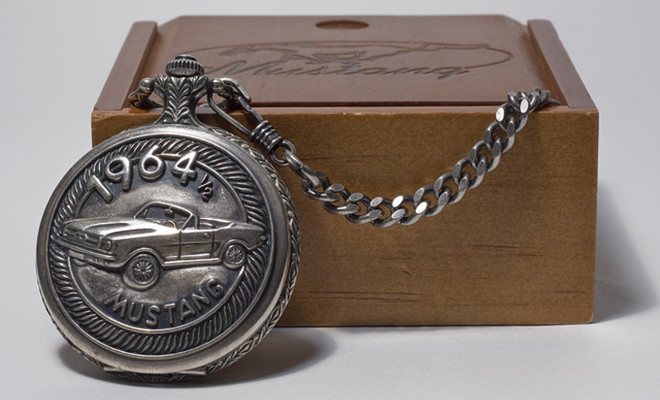 photo credit: jelloneck
photo credit: jelloneck
Watches
10 Things You Didn’t Know About Antique Pocket Watches
Whether you’re an avid watch collector or a newcomer to the world of vintage timepieces, there are a few things you should know before you head to the flea market or auction to try and find prized antique pocket watches. Read on for 10 tips shared by expert watch collectors to help you navigate the often choppy waters of finding the perfect vintage pocket watch.
Antique Pocket Watches – Navigating the buying waters!
1.) There are fakes out there and they are everywhere. Fake vintage watches are a thing. No, really. It’s not just Birkin bags that are being knocked off, today’s criminals are trying to recreate classic pocket watches in hopes of catching an unsuspecting buyer. Regardless of what type of watch you’re looking for, remember to read up on the history and identifiable features of the watch so you can easily spot a fake. That will help prevent you from becoming a victim.
If you’re trying to flip vintage watches rather than collect them, re-selling a fake, even unknowingly can be a crime. Protect yourself by not buying fakes in the first place. Even if a watch seems real, if you’re getting a bad gut feeling about the seller you should move on before you get taken advantage of.
2.) If you’re collecting for yourself, only buy the truly special pieces. That means you should look for timepieces that are no longer in production or that were one-off orders for special occasions or important individuals. Companies that have gone out of business are particularly desirable, especially if they made a signature piece or supplied a pocket watch for an important individual or event before going under.
3.) Consider the condition of the pocket watch. Antique pocket watches come in all conditions. Some may be scuffed or scratched, others may have discoloration on the dial. Always look at the face, the cover and the case. You should also check to see if the watch works and what condition the chain is in, if it’s present. Water and humidity can cause rust that can slowly eat away at the case of the piece and wreak havoc on the clockworks inside.
Certain cosmetic blemishes aren’t an issue. For antique pocket watches, tarnish is almost par for the course. Things that can be polished away shouldn’t be considered when looking at a piece. A broken hinge or a missing screw can all be repaired easily, but dents and missing identifiable watch components can be a much bigger problem and eat away at the value of the watch.
4.) Think about the age of the watch. Watches aren’t considered vintage until they are about 75 years old. Some collectors would argue that a watch has to also be out of production to be considered vintage, regardless of the age. Because there is no hard and fast rule regarding when a watch officially becomes vintage, it’s up to the collector to set their own standards.
For the casual collector, the precise age of the timepiece doesn’t matter as much. If you find a watch you love that’s only 50 years old, you can consider that vintage and purchase it for your collection. Because 75 years seems to be the threshold for a lot of vintage pocket watch collectors, antique shops that sell antique pocket watches may charge more for pieces that are over that age.
5.) Take the brand into consideration. Obviously Rolex, Movado and other high-end brands will sell for more. The top brands tend to retain not only their value better, but also their condition. Many collectors choose a single brand to focus on, collecting pocket watches from that one brand and ignoring others. Brands that have been in production for many years may have several vintage pocket watches in their collection, giving collectors plenty of pieces to chase after.
6.) Pay attention to whether or not the watch has all of its original parts. Vintage watches with original parts will always have a higher value than ones that have replaced or non-original parts. For example, when looking at a vintage Rolex watch, look for the original acrylic crystal glass that covers the watch’s face. Sapphire crystal, the modern material of choice, wasn’t introduced until the 1980s and should not be present on a vintage watch.
Also pay attention to the watch hands, touch-ups on the dial, knobs and other small details. Pay attention to details like hinges and other hardware pieces that tend to deteriorate over time and require replacing. Sometimes, antique pocket watch dealers will replace the back cover of the watch if it has been personalised in an attempt to restore the piece.
7.) Look for any special markings or manufacturer IDs. Some manufacturers stamped their pocket watches with their name or a special symbol identifying the piece. Older watches are often marked in this manner to identify the maker and the year that the watch was made. Look at the the backside of the watch and around the knobs or other inconspicuous places to find such markings.
Remember, letters and numbers won’t always be part of this type of brand marker. A small symbol, a crest or even an unassuming mark may help identify the watch’s maker and year of manufacture. You can consult a watch specialist if you need help identifying a mark.
8.) Question prices that seem too low. Often, an antique dealer will price vintage pocket watches lower if they can’t authenticate the piece. Knock off or fake watches will be very inexpensive. Sometimes, individuals selling antique pocket watches won’t know their true value, so they may price the pieces much lower than a dealer would. This doesn’t necessarily indicate a knock-off, but if the person selling the watch seems knowledgeable about vintage timepieces and still prices it low, you may want to proceed with caution.
If purchasing from a dealer, ask questions about the watch and get as much information as possible. If purchasing from an individual, ask about the history of the piece, how they acquired it, etc. If the price is low enough and you can afford to absorb the cost of purchasing a fake, take a chance if it’s a piece you truly care for. The worst case scenario would be that you have a watch that isn’t worth a lot of money, but brings you great joy.
9.) Protect your investment. If you’re spending a lot of money collecting vintage watches, make sure you have adequate insurance on your collection. Make sure you have a secure place to store the watches and make sure they are properly cared for. Boxes or cases are a good idea if you have multiple watches and want to keep them looking their best for many years. For insurance purposes, have your collection appraised and make sure you take out at least that amount in coverage.
10.) Don’t forget to have fun. Collecting vintage or antique pocket watches should be fun. If at any point collecting fails to become fun or bring you the joy that you once got from it, it’s probably time to discontinue your hobby or to take it less seriously.













